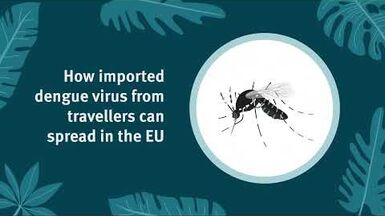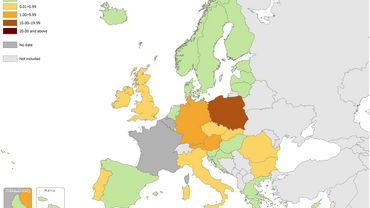Table. Number of rubella cases by month and notification rate (cases per million) by country, June 2016 to May 2017, EU/EEA countries
Download
Date of data retrieval from TESSy 30 June 2017.
| Country | 2016 | 2016 | 2016 | 2016 | 2016 | 2016 | 2016 | 2017 | 2017 | 2017 | 2017 | 2017 | Total cases | Cases per million | Total lab-positive cases |
|---|---|---|---|---|---|---|---|---|---|---|---|---|---|---|---|
| Jun | Jul | Aug | Sep | Oct | Nov | Dec | Jan | Feb | Mar | Apr | May | ||||
| Austria | 0 | 0 | 1 | 0 | 0 | 0 | 0 | 0 | 0 | 24 | 1 | 1 | 27 | 3.11 | 23 |
| Bulgaria | 0 | 1 | 0 | 0 | 0 | 1 | 1 | 0 | 0 | 0 | 0 | 0 | 3 | 0.42 | 0 |
| Croatia | 0 | 0 | 0 | 0 | 0 | 0 | 0 | 0 | 0 | 0 | 0 | 0 | 0 | 0 | 0 |
| Cyprus | 0 | 0 | 0 | 0 | 0 | 0 | 0 | 0 | 0 | 0 | 0 | 0 | 0 | 0 | 0 |
| Czech Republic | 0 | 0 | 0 | 0 | 0 | 0 | 0 | 0 | 0 | 0 | 1 | NR | 1 | 0.09 | 1 |
| Denmark | 0 | 0 | 0 | 0 | 0 | 0 | 0 | 0 | 0 | 0 | 0 | 0 | 0 | 0 | 0 |
| Estonia | 0 | 0 | 0 | 0 | 0 | 0 | 0 | 0 | 0 | 0 | 0 | 0 | 0 | 0 | 0 |
| Finland | 0 | 0 | 0 | 0 | 0 | 0 | 0 | 0 | 0 | 0 | 0 | 0 | 0 | 0 | 0 |
| Germany | 15 | 15 | 3 | 4 | 3 | 7 | 5 | 5 | 4 | 8 | 7 | 9 | 85 | 1.03 | 20 |
| Greece | 0 | 0 | 0 | 0 | 0 | 0 | 0 | 0 | 0 | 0 | 0 | 0 | 0 | 0 | 0 |
| Hungary | 0 | 0 | 0 | 0 | 0 | 0 | 0 | 0 | NR | NR | NR | NR | 0 | 0 | 0 |
| Iceland | 0 | 0 | 0 | 0 | 0 | 0 | 0 | 0 | 0 | 0 | 0 | 0 | 0 | 0 | 0 |
| Ireland | 0 | 0 | 0 | 0 | 0 | 0 | 0 | 0 | 0 | 1 | 0 | 0 | 1 | 0.21 | 0 |
| Italy | 6 | 1 | 1 | 0 | 3 | 4 | 2 | 3 | 6 | 10 | 10 | 9 | 55 | 0.91 | 24 |
| Latvia | 0 | 0 | 0 | 0 | 0 | 0 | 0 | 0 | 0 | 0 | 0 | 0 | 0 | 0 | 0 |
| Lithuania | 0 | 0 | 0 | 0 | 0 | 0 | 0 | 0 | 0 | 0 | 0 | 0 | 0 | 0 | 0 |
| Luxembourg | 0 | 0 | 0 | 0 | 0 | 0 | 0 | 0 | 0 | 0 | 0 | 0 | 0 | 0 | 0 |
| Malta | 0 | 0 | 0 | 0 | 0 | 0 | 0 | 0 | 0 | 0 | 0 | 0 | 0 | 0 | 0 |
| Netherlands | 0 | 0 | 0 | 0 | 0 | 0 | 0 | 0 | 0 | 0 | 0 | 0 | 0 | 0 | 0 |
| Norway | 0 | 0 | 0 | 0 | 0 | 0 | 0 | 0 | 0 | 0 | 0 | 0 | 0 | 0 | 0 |
| Poland | 113 | 52 | 47 | 46 | 78 | 57 | 70 | 50 | 39 | 49 | 51 | 64 | 716 | 18.86 | 9 |
| Portugal | 2 | 0 | 0 | 0 | 0 | 1 | 0 | 0 | 0 | 1 | 0 | NR | 4 | 0.39 | 0 |
| Romania | 1 | 0 | 3 | 0 | 1 | 2 | 2 | 1 | 0 | 0 | 0 | NR | 10 | 0.51 | 10 |
| Slovakia | 0 | 0 | 0 | 0 | 0 | 0 | 0 | 0 | 0 | 0 | 1 | 0 | 1 | 0.18 | 0 |
| Slovenia | 0 | 0 | 0 | 0 | 0 | 0 | 0 | 0 | 0 | 0 | 0 | 0 | 0 | 0 | 0 |
| Spain | 0 | 0 | 0 | 0 | 0 | 0 | 0 | 0 | 0 | 0 | 0 | NR | 0 | 0 | 0 |
| Sweden | 0 | 0 | 0 | 0 | 0 | 0 | 0 | 0 | 0 | 0 | 0 | 0 | 0 | 0 | 0 |
| United Kingdom | 0 | 0 | 0 | 0 | 0 | 1 | 0 | 0 | 0 | 0 | 1 | 0 | 2 | 0.03 | 2 |
| Total | 137 | 69 | 55 | 50 | 85 | 73 | 80 | 59 | 49 | 93 | 72 | 83 | 905 | 2.1 | 89 |
NR = Data not reported. Notification rates were calculated using the most recent population estimates available from Eurostat (2015).
Comment:
The national surveillance system for rubella in Denmark currently only captures rubella infections during pregnancy; therefore the true incidence of rubella in the Danish population will be underestimated.
Belgium and France do not operate rubella surveillance systems with national coverage and therefore do not contribute data to the EU/EEA enhanced rubella surveillance.
The target to monitor progress towards elimination is achievement of an incidence of less than one case per million population per year (including confirmed, probable and possible cases but excluding imported cases). Achieving this target is consistent with progress towards elimination but does not define elimination or confirm that it has been achieved. In the table, all cases (endemic, imported, import-related) are included for the calculation of the notification rate.
For countries that did not report data for all 12 months, notification rates might be underestimated.
All confirmed, probable, possible or unknown cases, as defined by the EU 2008 case definition, are included.
Cases were defined as laboratory-positive if at least one of the following variables was reported as positive: serological test for IgG, serological test for IgM, virus detection or isolation or IgG avidity test.
Note:
The number of cases are displayed according to month of statistics, which contains a date chosen by the country for reporting purposes. This date may indicate the onset of disease, the date of diagnosis, the date of notification, or the date of laboratory confirmation.
Countries report on rubella and other vaccine-preventable diseases to TESSy at their own convenience. This implies that the date of retrieval can influence the presentation of data. Inconsistencies with measles data reported previously might arise as countries may update their data in TESSy retrospectively.
Comparisons between countries should be made with caution because of dissimilar surveillance sensitivities, completeness of reporting and different reporting procedures. Moreover, under-notification is a well recognized limitation of nationwide mandatory notification systems.






